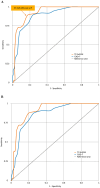Validating the Traditional Chinese version of the Epilepsy Anxiety Survey Instrument (EASI) in Hong Kong
- PMID: 40697570
- PMCID: PMC12279500
- DOI: 10.3389/fneur.2025.1604317
Validating the Traditional Chinese version of the Epilepsy Anxiety Survey Instrument (EASI) in Hong Kong
Abstract
Background: Anxiety disorders are common and have a substantial impact on people with epilepsy (PWE). However, they often go under-recognized. In recent years, epilepsy-specific anxiety has gained increasing attention in the literature. To improve mental health care for people with epilepsy (PWE), we developed and validated the traditional Chinese versions of the Epilepsy Anxiety Survey Instrument (EASI) and its brief screener (brEASI) among PWE in Hong Kong.
Method: We developed the TC-EASI through forward and backward translation, followed by a review by an expert panel and a focus group. We tested the instrument among PWE aged 18 years and older using the Chinese Bilingual version of the Structured Clinical Interview for the Diagnostic and Statistical Manual of Mental Disorders, 4th Edition, Text Revision (CB-SCID), which is the gold standard for diagnosing anxiety disorders. We examined the internal consistency and the test-retest reliability of the TC-EASI and TC-brEASI. We performed confirmatory factor analysis (CFA) to assess the factor structure of the TC-EASI. We also examined convergent and divergent validity using the Generalized Anxiety Disorder 7-item scale (GAD-7), the Neurological Disorders Depression Inventory for Epilepsy (NDDI-E), the Depression Anxiety Stress Scales 21 (DASS-21), and the Liverpool Adverse Events Profile (LAEP). Furthermore, we analyzed the receiver operating characteristics (ROC) of the TC-brEASI.
Results: We included 203 Chinese PWE; 19.7% had at least one current anxiety disorder, 7.4% had a panic disorder, and 5.9% had agoraphobia without panic disorder. Both internal consistency and test-retest reliability were satisfactory. The TC-EASI revealed two latent constructs: epilepsy-specific anxiety and typical anxiety. Convergent and divergent validity were established. A cut-off score of ≥9 for the TC-brEASI yielded a sensitivity of 89.2% (95% CI = 79.2-99.2%), a specificity of 82.5% (95% CI = 76.8-88.3%), and an area under curve (AUC) of 0.925 (95% CI = 0.887-0.964).
Conclusion: The traditional Chinese versions of the EASI and brEASI are reliable and valid epilepsy-specific measures.
Keywords: EASI; anxiety disorders; epilepsy; epilepsy-specific anxiety; screening.
Copyright © 2025 Chan and Wong.
Conflict of interest statement
The authors declare that the research was conducted in the absence of any commercial or financial relationships that could be construed as a potential conflict of interest.
Figures



Similar articles
-
Not always that EASI: Validating the Russian version of the epilepsy anxiety survey instrument and its brief counterpart.Epilepsy Behav. 2022 Aug;133:108801. doi: 10.1016/j.yebeh.2022.108801. Epub 2022 Jun 23. Epilepsy Behav. 2022. PMID: 35753109
-
Signs and symptoms to determine if a patient presenting in primary care or hospital outpatient settings has COVID-19.Cochrane Database Syst Rev. 2022 May 20;5(5):CD013665. doi: 10.1002/14651858.CD013665.pub3. Cochrane Database Syst Rev. 2022. PMID: 35593186 Free PMC article.
-
Therapist-supported Internet cognitive behavioural therapy for anxiety disorders in adults.Cochrane Database Syst Rev. 2016 Mar 12;3(3):CD011565. doi: 10.1002/14651858.CD011565.pub2. Cochrane Database Syst Rev. 2016. PMID: 26968204 Free PMC article.
-
Validation of the Chinese version of the Connor-Davidson Resilience Scale-10 among young people in Hong Kong.East Asian Arch Psychiatry. 2025 Jun;35(2):96-102. doi: 10.12809/eaap2565. East Asian Arch Psychiatry. 2025. PMID: 40583750
-
Therapist-supported Internet cognitive behavioural therapy for anxiety disorders in adults.Cochrane Database Syst Rev. 2015 Mar 5;(3):CD011565. doi: 10.1002/14651858.CD011565. Cochrane Database Syst Rev. 2015. Update in: Cochrane Database Syst Rev. 2016 Mar 12;3:CD011565. doi: 10.1002/14651858.CD011565.pub2. PMID: 25742186 Updated.
References
LinkOut - more resources
Full Text Sources

